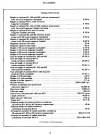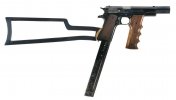M1 carbine was at 5.5 with an empty 15rd mag and without sling (requirement was 5lb, so no biggie), and a bit above 6 lbs with sling and ammo, with 300 yds effective range.
For the sake of discussion, let's say that US Army's requirement is different this time. It calls for an even lighter weapon (3.5lb without ammo and sling, 4 lb with ammo and sling) , with effective range comparable with the Thompson SMG, ie. 150 yards. Extra merit points can be earned if the 'light carbine' has the effective range of 200 yds. Note that low specified weight and relatively long range will most likely exclude the simple blowback weapons. Semi-automatic fire. A 15 rd detachable magazine is required.
Ammo choice - anything that can be designed and manufactured by the ammo technology of the day. Use the existing cartridge (home grown or foreign), or a suitably modified existing cartridge, or something new. Bullet of the chosen ammo type, when fired from carbine, needs to be able to incapacitate an enemy soldier up to at least 150 yds.
(specs for the M1/2/3 Carbine are attached)

For the sake of discussion, let's say that US Army's requirement is different this time. It calls for an even lighter weapon (3.5lb without ammo and sling, 4 lb with ammo and sling) , with effective range comparable with the Thompson SMG, ie. 150 yards. Extra merit points can be earned if the 'light carbine' has the effective range of 200 yds. Note that low specified weight and relatively long range will most likely exclude the simple blowback weapons. Semi-automatic fire. A 15 rd detachable magazine is required.
Ammo choice - anything that can be designed and manufactured by the ammo technology of the day. Use the existing cartridge (home grown or foreign), or a suitably modified existing cartridge, or something new. Bullet of the chosen ammo type, when fired from carbine, needs to be able to incapacitate an enemy soldier up to at least 150 yds.
(specs for the M1/2/3 Carbine are attached)

Last edited:
